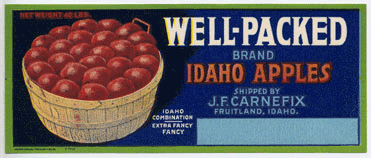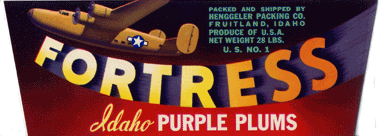 Marauding Indians stole sheep often. Frontier life didn't suit him. His fear of Indians made him decide to go into farming north of Payette. After working for wages constructing irrigation ditches he saved enough money to buy 200 acres.
Marauding Indians stole sheep often. Frontier life didn't suit him. His fear of Indians made him decide to go into farming north of Payette. After working for wages constructing irrigation ditches he saved enough money to buy 200 acres. In 1908, C. B. Henggeler purchased a farm 1 1/2 miles south of Fruitland and planted an orchard. In 1909 his father, Charles Henggeler, purchased an adjoining farm raising fruit, hay, grain and dairy cattle. All the family worked on the farm and in the orchards. The family still owns their original land holdings, and in 1939, the Henggeler Packing Company was organized. A packing plant, originally owned by the McMillan Fruit Company at Buckingham railroad siding, became part of, and still is, the site of the Henggeler Packing Company operations. Their brand name is "Fortress." An apple sizer was purchased and is believed to be the first of its kind in the apple business. Cold storage warehouses were built and controlled atmosphere - some of the earliest in Idaho's apple industry.
In 1908, C. B. Henggeler purchased a farm 1 1/2 miles south of Fruitland and planted an orchard. In 1909 his father, Charles Henggeler, purchased an adjoining farm raising fruit, hay, grain and dairy cattle. All the family worked on the farm and in the orchards. The family still owns their original land holdings, and in 1939, the Henggeler Packing Company was organized. A packing plant, originally owned by the McMillan Fruit Company at Buckingham railroad siding, became part of, and still is, the site of the Henggeler Packing Company operations. Their brand name is "Fortress." An apple sizer was purchased and is believed to be the first of its kind in the apple business. Cold storage warehouses were built and controlled atmosphere - some of the earliest in Idaho's apple industry.
| Read More Articles by Ron Marlow | Learn More about Mr. Marlow |